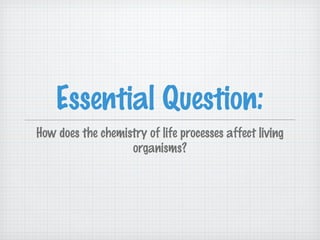
Comparing Macromolecules in Living Organisms
- 1. Essential Question: How does the chemistry of life processes affect living organisms?
- 2. Standards BIO.A.2.2.3: Compare and contrast the structure and function of carbohydrates, lipids, proteins, and nucleic acids in organisms.
- 3. Grade 10 Biology 3 blocks 3 blocks 3 blocks
- 4. Goals: 1. Students will be able to differentiate between all 4 macromolecules. 2. Students will be able to compare and contrast the functions and structures of all 4 macromolecules
- 5. Technology needed: Mobile device (smart phone, tablet, lap top) Internet access for : mindmeister presentation media of choice
- 6. Activities Students will be paired up assigned a macromolecule (protein, carb, lipid, nucleic acid) research characteristics of given macromolecule on mobile device Get together with others that have same topic. As a group make a mind map on mindmeister. Decide on presentation tool Develop presentation
- 7. Assessment Rubric that focuses on : correct content creativity working with peers (collaboration) presentation (format) presenting
- 8. What if they do not have a mobile device? A student that does not have a mobile device can use a school issued lap top.
- 9. Technology Management STudents will be given the acceptable and responsible use guidelines Students will be monitored throughout lesson School laptops will be stored in classroom when not in use during class.
- 10. Technology Management STudents will be given the acceptable and responsible use guidelines Students will be monitored throughout lesson School laptops will be stored in classroom when not in use during class.
Notes de l'éditeur
- The essential question (taken directly from my curriculum) is How does the chemistry of life processes affect living organisms? There are multiple key questions to go along with this. The one that will be focused on in this lesson is How do macromolecules influence life functions.
- Taken from the SAS site, biology standard A. 2.2.3 addresses the issue of comparing and contrasting the structure and function of the 4 macrmolecules. Student need to be able to identify the difference betweeen the four, especially protein and carboyhydrates.
- This lesson is for a tenth grade biology class that spans over 3, 80 minute blocks. The first block is for researching and meeting with the group to make the mind map, the second block is for putting together the presentation and the third block is for presenting.
- In order for students to be successful on the keystone exam, they need to know the difference between a carbohydrate, protein, lipid, nucleic acid. They need to be able to identify the molecules based on structure. They also need to be able to complete a constructed response on the difference in function of each.
- Mobile devices will be used for research. Students can use their smart phone to do their individual research. Tablets may also be used. They will need to be able to access mindmeister on their phones. Their presentations will be built on their mobile device but must be accessed through the web so it can be presented to the class on my laptop or another classroom computer
- To begin the class, the students will be put into groups. Each group will be assigned 1 of the 4 macromolecules. There will be more than 1 group researching a given macromolecule. As a pair they will research their topic and complete a guided question sheet. They may use their phones or tables to do this. Once they are finished they will be put with the other groups that researched the same topic to compare notes. After they have done that, as a larger group they will create a mind map using mindmeister.com This mind map will be printed and used as a hand out for their presentation. They will then decide on a presentation tool to present their findings to the rest of the class. They will be responsible for teaching the class on that particular topic. The presentation must be web based and accessed through a link so it can be displayed on the board.
- The rubric used with have 5 different components. They must have the correct content. Creativity will be judged based on their mind map and type of presentation. Collaboration with their group will be assessed. They will also have a change to ‘grade’ their partners with an anonymous grade sheet. That score will factor into their collaboration grade. The format of the presentation will also be assessed. Is it easy to follow, did they use the media correctly, does it look nice? Finally the actual presentation will be graded. Everyone must talk during the presentation. The handout should be printed for everyone in the class.
- There is a classroom laptop cart can that be used. Students who do not want to use their device or do not have a device that can do this activity are given the lap tops to use.
- Before this unit, students will be given the guidelines and taught how to use it responsibly. During the lesson, the teacher will walk around and monitor the students progress on the project.